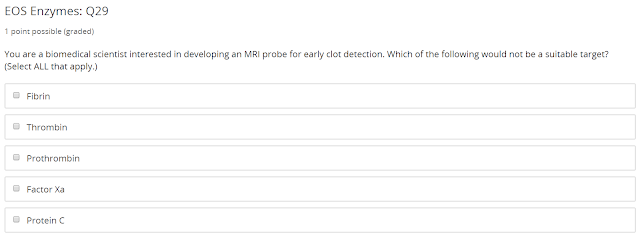The answer is factor XIII, this factor allows fibrin to form stable mesh.
Factor X will activate prothrombin to start the blood coagulation cascade, so this patient would have blood clot even if there is no wound, therefore the answer is thrombosis.
When we have a wound, the collagen fibers are exposed to the plasma, the circulatng von Willebrand factor binds to the collagen, shear force unfold the vWF and then the unfolded vWF binds to the platelet receptor.
Therefore the answers are
Clot initiation is triggered by tissue damage exposing collagen fibers that are normally "invisible" to the plasma.
Shear force produced by the tissue damage cause vWF to unfold and interact with collagen fibers.
vWF binds platelet receptors and activate them.
Note that platelet is also recruited by fibrinogen during the blood clot initiation, not by fibrin. The two heads of a fibrinogen molecule can attach to two activated platelets.
Once the blood clot is initiated, the clot need to grow, this is done by secretion of ADP and thromboxane A2 by activated platelet. Therefore the answer is:
Extension is largely mediated by factors secreted by activated platelets at cut site, and
ADP and thromboxane A2 (TxA2) are agonist that recruits and activate additional platelets during extension phase.
Prothrombin and Protein C are zymogens. They are always present and therefore they are not suitable targets.
I only know about Bacteriophage screen, so that must be the answer :p
Looking up the other screens on Google yield some interesting read, I will read them later.
The heavy water option is interesting and I did some lookup on Google. People did patent using heavy water as MRI contrasting agent, but it is not a great candidate because heavy hydrogen has stronger hydrogen bond properties, and often cause disruption in normal biochemical reactions.
Pure heavy metal does give strong magnetic signal - but it is toxic.
We do not want radioactivity - so radioactive glocuse is not great.
We are detecting blood clot, so it better stay in the plasma, fatty acid is hydrophobic and will likely leave the blood vessel, not a great candidate either.
Therefore the answer is a heavy metal enclosed in a chelator to maximize contrast and prevent toxicity.
To do ISM, we need to know the molecule fairly well to have good candidate for target sites. That gives us enzyme C. Enzyme D requires multiple steps assay and is less than ideal.
It is simply $ 4 \times 3 \times 2 = 24 $
Note that the question is asking for the third round, the next round will be on library A, and the next next round (i.e. the third round) will be on library B.
The best order is B > A > D > C.
In this problem - the mutant are all fairly similar. The aspartate to lysine change is a relatively bigger one, so I chose this one, and it is correct.












No comments:
Post a Comment